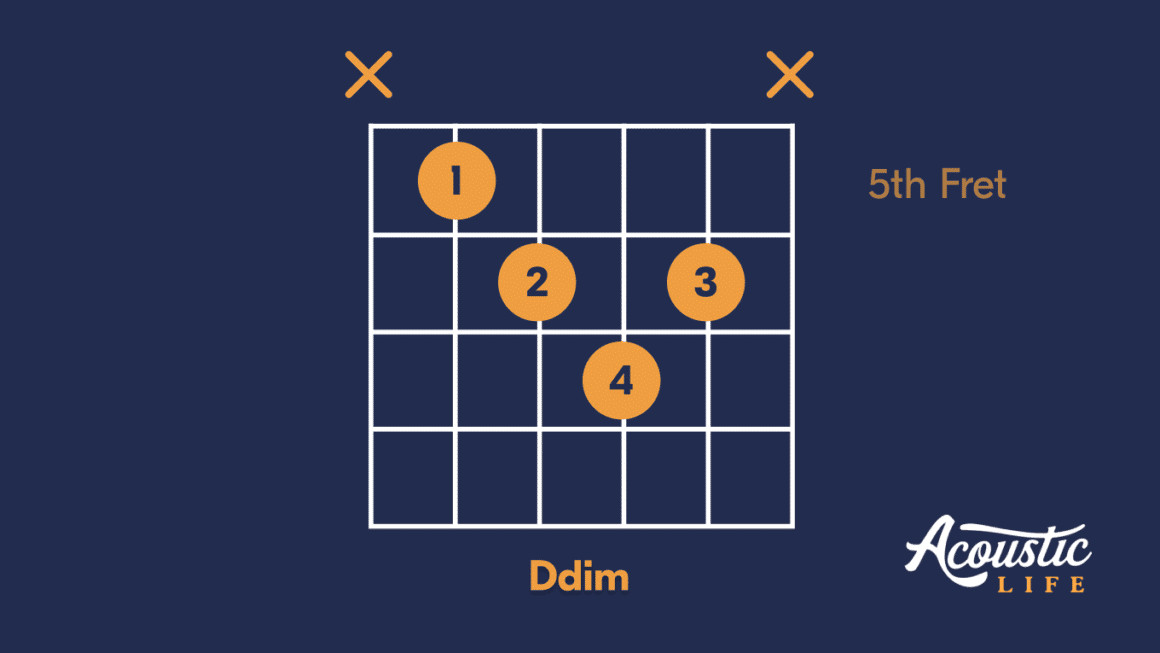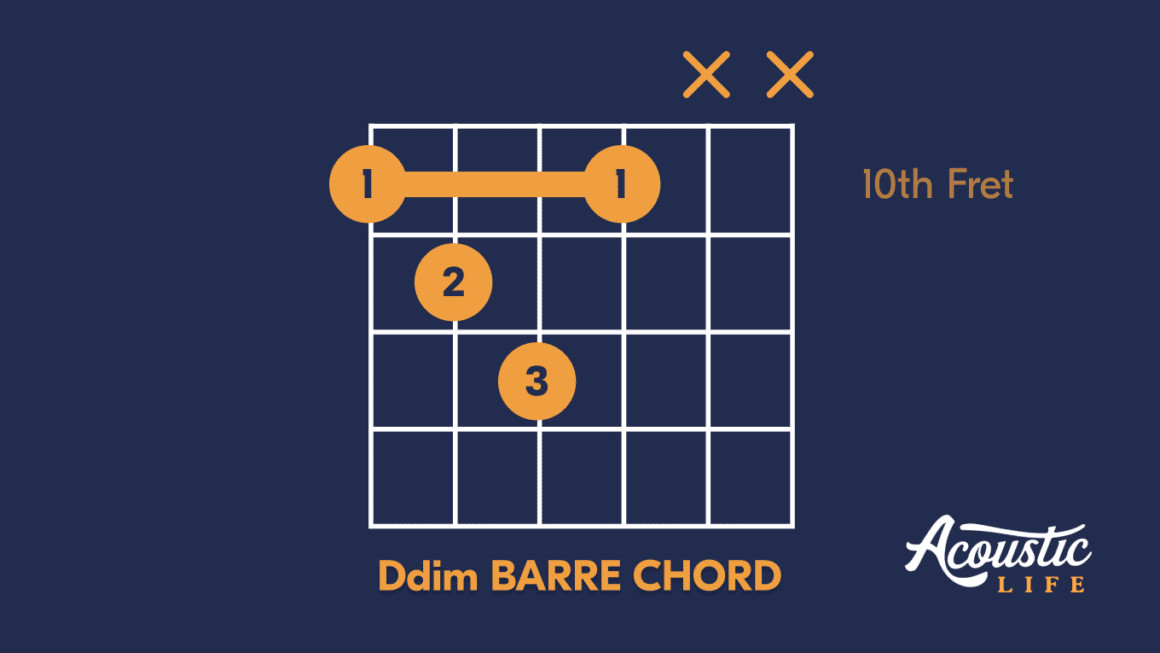The D Dim Guitar Chord, often written as Ddim or D°, might seem like an advanced or unusual chord at first glance. While it’s true it’s not typically one of the first chords beginners learn, adding the Ddim chord to your repertoire can significantly expand your musical palette. It’s a chord that injects a unique flavor into your playing, appearing across diverse genres from pop to classical music.
Like any chord, the key to unlocking the Ddim’s potential lies in understanding its construction, proper technique, and how to effectively integrate it into your music. If you’re ready to move beyond basic chords and explore richer, more complex sounds, the Ddim chord is an excellent place to start. Let’s dive in and discover the world of diminished chords!
What Exactly is a D Diminished Chord?
The Ddim chord, or D diminished chord, stands apart from its more common relatives like the D major and D minor chords. Diminished chords, in general, are known for their distinctive sound, often described as dramatic, tense, or even eerie. This unique character stems from their specific musical structure, particularly the “flattened fifth.”
To understand the Ddim chord, we need to look at its building blocks. It’s constructed using the root (D), the flat third (F), and the flat fifth (Ab) of the D major scale. This combination of notes creates a dissonant sound, meaning it sounds somewhat unresolved and creates a sense of tension that often seeks resolution in the music that follows.
Think of dissonant chords like musical question marks. They create intrigue and anticipation, making the resolution to a consonant chord even more satisfying.
Consonant chords on the other hand, are built from notes that sound harmonious and pleasing together, creating a sense of stability and resolution. Understanding the interplay between dissonance and consonance is crucial for adding depth and emotion to your guitar playing.
Dissonant vs. Consonant: A Quick Definition
To clarify the difference:
- Consonant Chord: A chord that sounds stable, harmonious, and resolved.
- Dissonant Chord: A chord that sounds tense, unstable, and often seeks resolution to a consonant chord.
Perfecting Your Finger Positioning for the Ddim Chord
Like all guitar chords, mastering the Ddim chord involves precise finger placement. Many guitarists, especially when learning new or more complex chords, can struggle with finger positioning. Incorrect placement can lead to muted strings, buzzing, and an overall unclear or weak sound.
Here are some essential tips to ensure your finger positioning is spot-on for the Ddim chord and any other chord you learn:
- Hand Relaxation: Begin with a relaxed hand and arm. Tension is the enemy of smooth chord transitions and clear sound. Shake out your hand and arm to release any stiffness before you start.
- Finger Arching: Imagine you’re holding a small ball in your palm. This helps naturally arch your fingers, allowing the tips to press down on the strings without accidentally muting adjacent strings.
- Optimal Pressure: Apply just enough pressure to cleanly fret the notes and avoid fret buzz. Pressing too hard creates unnecessary tension and fatigue in your hand. Finding the sweet spot of pressure is key.
Step-by-Step Guide: Playing the Standard Ddim Chord
Now, let’s get practical and learn how to play the standard version of the Ddim chord. This common voicing is played starting at the 5th fret.
 Ddim chord diagram showing finger positions on the guitar fretboard. Index finger on the 5th fret of the A string, middle finger on the 6th fret of the D string, ring finger on the 6th fret of the B string, and pinky finger on the 7th fret of the G string. Strings to be strummed are indicated by numbers, excluding the high and low E strings.
Ddim chord diagram showing finger positions on the guitar fretboard. Index finger on the 5th fret of the A string, middle finger on the 6th fret of the D string, ring finger on the 6th fret of the B string, and pinky finger on the 7th fret of the G string. Strings to be strummed are indicated by numbers, excluding the high and low E strings.
Follow these steps to play the standard Ddim chord:
- Index Finger: Place your index finger on the 5th fret of the 5th string (A string).
- Middle Finger: Place your middle finger on the 6th fret of the 4th string (D string).
- Ring Finger: Place your ring finger on the 6th fret of the 2nd string (B string).
- Pinky Finger: Place your pinky finger on the 7th fret of the 3rd string (G string).
- Strumming: Strum all strings from the 5th string (A string) down to the 3rd string (G string). Avoid strumming the 6th string (low E) and the 1st string (high E).
Congratulations! You are now playing the Ddim chord. Listen to the unique, slightly unsettling yet intriguing sound it produces.
Exploring the Ddim Barre Chord Version
For a slightly more challenging and sonically different voicing, you can try the barre chord version of the Ddim chord. Barre chords require more finger strength and dexterity but offer versatility and allow you to play chords in different positions on the neck.
 Ddim barre chord diagram illustrating finger placement on the guitar neck. Index finger barring across the 10th fret of the low E, A, and D strings. Middle finger on the 11th fret of the A string. Ring finger on the 12th fret of the D string. Strings to be strummed are indicated, excluding the B string and the high E string.
Ddim barre chord diagram illustrating finger placement on the guitar neck. Index finger barring across the 10th fret of the low E, A, and D strings. Middle finger on the 11th fret of the A string. Ring finger on the 12th fret of the D string. Strings to be strummed are indicated, excluding the B string and the high E string.
Here’s how to play the Ddim barre chord:
- Barre: Barre your index finger across the 6th string (low E), 5th string (A), and 4th string (D) at the 10th fret. Ensure all three strings are pressed down cleanly.
- Middle Finger: Place your middle finger on the 11th fret of the 5th string (A string).
- Ring Finger: Place your ring finger on the 12th fret of the 4th string (D string).
- Strumming: Strum all strings from the 6th string (low E) down to the 3rd string (G string). Avoid strumming the 2nd string (B) and the 1st string (high E).
This barre version of the Ddim chord provides a fuller, slightly more powerful sound and is useful when you need to play the Ddim chord in a different part of the fretboard.
Effective Exercises for Mastering the Ddim Chord
Practice is crucial for solidifying any new chord. Muscle memory is key to playing chords smoothly and effortlessly. Here are a couple of effective exercises to help you master the Ddim chord:
-
Repetition Exercise:
- Form the Ddim chord (either standard or barre version).
- Strum the chord cleanly four times.
- Release your hand from the chord, letting your fingers relax.
- Strum the open strings (or a simple open chord like E minor) four times.
- Repeat this cycle for 5-10 minutes daily.
-
Chord Switching Exercise: This exercise helps you integrate the Ddim chord into musical contexts and familiarize yourself with its sound in relation to other chords.
- Start by playing a D major chord for four strums.
- Switch smoothly to the Ddim chord and strum it four times.
- Then, switch to a D minor chord and strum four times.
- Cycle through D major – Ddim – D minor repeatedly.
- Experiment with other chord progressions, substituting the Ddim chord in places where you want to create tension or a dramatic effect.
Incorporating the Ddim Chord into Your Music and Next Steps
The Ddim chord, while not as common as major or minor chords, is a valuable tool for adding color and depth to your guitar playing. It’s often used as a passing chord to create smooth transitions between other chords, or to inject a moment of suspense or drama into a song.
Listen to songs in genres like jazz, classical, and even pop and rock music, and you might be surprised to hear the subtle yet powerful effect of diminished chords. Experiment with incorporating the Ddim chord into your own songwriting or when learning to play existing songs.
As you progress on your guitar journey, exploring more advanced chords and musical concepts will further enrich your playing. Consider learning other diminished chords in different keys and positions, and delve deeper into music theory to understand how diminished chords function within chord progressions and song structures.
To continue expanding your chord vocabulary, you might find it beneficial to explore guides on chords like the B7 chord or the Am chord. These resources, along with consistent practice and exploration, will empower you to become a more versatile and expressive guitar player.
Unlocking the Ddim guitar chord opens up a world of sonic possibilities. Embrace its unique sound, practice diligently, and enjoy the dramatic flair it brings to your music!

